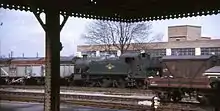GWR 6100 Class
The GWR 6100 Class is a class of 2-6-2T side tank steam locomotives.
| GWR 6100 Class | |||||||||||||||||||||||||||||||||||||||||||||||||||||||||
|---|---|---|---|---|---|---|---|---|---|---|---|---|---|---|---|---|---|---|---|---|---|---|---|---|---|---|---|---|---|---|---|---|---|---|---|---|---|---|---|---|---|---|---|---|---|---|---|---|---|---|---|---|---|---|---|---|---|
.jpg.webp) 6147 at Swindon Works on 26 April 1964 after overhaul | |||||||||||||||||||||||||||||||||||||||||||||||||||||||||
| |||||||||||||||||||||||||||||||||||||||||||||||||||||||||
| |||||||||||||||||||||||||||||||||||||||||||||||||||||||||
| |||||||||||||||||||||||||||||||||||||||||||||||||||||||||
| |||||||||||||||||||||||||||||||||||||||||||||||||||||||||
History

The class was designed by Charles Collett and introduced in 1931, and were a straightforward development of the earlier 5101 class (and for that matter the 1905 3100/5100 class). The main difference from their predecessors was an increased boiler pressure of 225 psi (1.55 MPa) with a consequent increase in tractive effort.[1]
There were seventy in the class, built in two batches in 1931–1933 and 1935. They were frequently referred to by trainspotters as 'Tanner One-ers'- being a reference to their '61xx' numbering sequence using colloquial terms for a sixpence and a penny.
The class was specifically built for commuter services in the London area where they replaced the ageing 2221 class on these services. They lasted to the end of steam on the Western Region of British Railways in 1965, never straying far from their home turf. Typical duties were Paddington to Aylesbury via High Wycombe, and from the same terminus to Oxford, Windsor, Reading and Basingstoke. They were mainly shedded at Old Oak Common, Southall, Slough, Reading and Aylesbury throughout their lives. In the early 1960s, the advent of the first generation diesel multiple units made them semi-redundant though generally far from worn out. Their last few years saw them on more menial duties, as in the adjacent photograph, until scrapping.[1]
Preservation

One locomotive, 6106, has survived into preservation, and is at Didcot Railway Centre, though currently non-operational.[2]
Models
The erstwhile Kitmaster company produced an unpowered polystyrene injection moulded model kit for 00 gauge. In late 1962, the Kitmaster brand was sold by its parent company (Rosebud Dolls) to Airfix, who transferred the moulding tools to their own factory; they re-introduced some of the former Kitmaster range, including this model. The tools were subsequently sold again to Dapol who have also produced this model.[3]
Triang also produced a powered model of 6157 in TT scale[4]
For some time Graham Farish have produced a N gauge model, it is dated compared with more modern models and its driving wheels are scale for the 3100 class, i.e. 5ft 3 inches, but is still a reasonable representation which forms a good base to add detail too.
Dapol is producing a completely new OO scale model of this class[5]
Hornby Railways is also retooling their OO scale model of this class[6]
See also
References
- le Fleming, H.M. (February 1962). White, D.E. (ed.). The Locomotives of the Great Western Railway, part nine: Standard Two-Cylinder Classes. RCTS. pp. J33–J34.
- "6106 - 61xx Class". Didcot Railway Centre. Retrieved 2 November 2008.
- Knight, Stephen (1999). Let's Stick Together: An Appreciation of Kitmaster and Airfix Railway Kits. Clopthill: Irwell Press. ISBN 1-871608-90-2.
- "Triang TT Locomotives". Archived from the original on 8 June 2009.
- "Proud to announce the launch of the all new OO Gauge GWR Large Prairie 2-6-2 Locomotive". Dapol. December 2017.
- "GWR, Class 61xx 'Large Prairie', 2-6-2T, 6110 - Era 3". Hornby.
External links
| Wikimedia Commons has media related to GWR 6100 Class. |